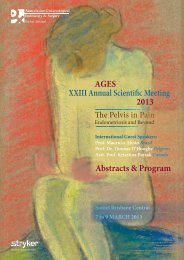to Obstetric Trauma Pelvic Floor Repair Surgical Essentials - AGES
to Obstetric Trauma Pelvic Floor Repair Surgical Essentials - AGES
to Obstetric Trauma Pelvic Floor Repair Surgical Essentials - AGES
You also want an ePaper? Increase the reach of your titles
YUMPU automatically turns print PDFs into web optimized ePapers that Google loves.
Program<br />
Abstracts<br />
Friday<br />
3 June<br />
procedures e.g. vaginal sacrospinous fixation, laparoscopic<br />
uterosacral plication, and laparoscopic mesh sacrocolpopexy and<br />
sacrohysteropexy that have largely superseded the Manchester<br />
<strong>Repair</strong>. While it is hardly ever performed in developed countries,<br />
fellows should know of its existence and technique when the<br />
occasional need arises.<br />
There are few comparative case studies in the modern literature<br />
apart from a study from Delft by de Boer and Thys from Veldhoven.<br />
In comparison <strong>to</strong> vaginal hysterec<strong>to</strong>my (VH) for prolapse,<br />
Manchester repair (MR) has less blood loss, shorter operating time,<br />
less morbidity with similar functional and ana<strong>to</strong>mical outcomes<br />
In conclusion I offer it as an additional viable modern alternative with<br />
application <strong>to</strong> women seeking uterine preservation and avoidance of<br />
mesh use.<br />
REFERENCES:<br />
1. Fothergill WE. Anterior colporrhaphy and its combination with<br />
Amputation of the cervix as a Single Operation, BJOG, 1915, 27:<br />
146 -147<br />
2. De Boer,T, Milani,A,Kluivers,K, Withagen,M,Vierhout M, The<br />
effectiveness of surgical correction of uterine prolapse: cervical<br />
amputation with uterosacral ligament placation ( Modified<br />
Manchester), Int Urogynecol J , 2009, 1313<br />
3. Thys,S, Coolen,A, Martens,I, Oosterbaan,H, Roovers,J, Mol,B,<br />
Bongers,M , A comparison of long term outcome between<br />
Manchester Fothergill and vaginal hysterec<strong>to</strong>my as treatment for<br />
uterine descent, Int Urogynecol J 2011<br />
AUTHOR AFFILIATION: Dr Michael McEvoy; Gynaecologist,<br />
Women’s and Children’s Hospital, North Adelaide, South Australia,<br />
Australia.<br />
Session 4 / 1600-1620<br />
Ring pessary use before, during, and<br />
after pregnancy<br />
Moore KH<br />
Vaginal ring pessaries can be used <strong>to</strong> manage prolapse,<br />
incontinence or both.<br />
The tradition Portex ring that most gynaecologists are familiar with is<br />
used for prolapse and thus would not usually involve women before<br />
pregnancy. However the Contiform device is very useful for stress<br />
incontinence in fit healthy young women who have no prolapse at all<br />
(Morris & Moore, Int Urogynae J, 2003), many of whom are nulliparous.<br />
During pregnancy, there is very little published data regarding<br />
the use of vaginal rings of any sort, however personal anecdotal<br />
experience in a handful of patients will be shared.<br />
The post partum and or post menopausal women is the largest<br />
consumer for vaginal pessaries of any type. An overview of the rings<br />
provided in the <strong>Pelvic</strong> <strong>Floor</strong> Unit at St George will be given.<br />
One of the main issues regarding vaginal ring pessaries is the long<br />
term outcome in women using it for many years: because very little<br />
data existed, we conducted a large scale of this subject (Sarma et<br />
al, Brit J O&G 2009).<br />
Over the 10 index years of the study (1992–2002), there were 27,<br />
732 attendances at the PFU. We identified 273 women who had<br />
prolapse as a main complaint. We also identified 189 women who<br />
complained of concomitant stress incontinence and had an Introl<br />
device fitted. The long term outcomes over a 14 years maximum<br />
duration will be described.<br />
AUTHOR AFFILATION: A/Prof Kate H Moore, The <strong>Pelvic</strong> <strong>Floor</strong> Unit,<br />
St George Hospital, UNSW, Sydney, NSW, Australia.<br />
Session 4 / 1620-1640<br />
Pregnancy after continence surgery<br />
Rosamilia A<br />
What is known about pregnancy, delivery, and the development of<br />
SUI<br />
Women with postpartum stress incontinence have significantly greater<br />
antenatal bladder neck mobility compared <strong>to</strong> continent women,<br />
indicating that biochemical changes in the connective tissues occur.<br />
5-10% of nullipara have urinary incontinence with an increase<br />
occurring in the mid trimester of pregnancy. The strongest predictive<br />
fac<strong>to</strong>r for the development of post partum urinary incontinence is<br />
mid pregnancy urinary incontinence. Older maternal age appeared<br />
<strong>to</strong> be predictive for bothersome stress urinary incontinence 1<br />
year postpartum. The first pregnancy and delivery contribute<br />
most <strong>to</strong> the development of urinary incontinence after delivery.<br />
Stress incontinence (any and not just bothersome) was present<br />
3 months after vaginal delivery and caesarean section in 34 and<br />
7%, respectively and after 12 months in 40 and 22%, respectively.<br />
Caesarean delivery is only partially protective.<br />
What happens with a mid-urethral sling or colposuspension during<br />
pregnancy<br />
9

















